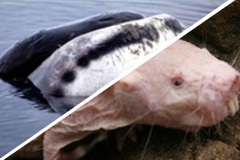Developing Genomic Resources and Methods for Studying Long-lived Species
Biomedical research, including most research on human diseases, is usually based on animal models that develop the disease under study at a higher incidence and rate than normal. An unexplored paradigm in biomedical research, however, is the use of disease-resistant organisms to identify genes, mechanisms and processes that protect against (rather than cause) disease. While disease models may be useful to develop treatments, models of resistance to disease may prove valuable for human disease prevention. In this context, one of our major goals is to develop genomic resources that help researchers study long-lived animals.
In 2007, we put forward a proposal to sequence the genomes of long-lived mammalian species: the naked mole-rat (Heterocephalus glaber), the capuchin monkey (Cebus capucinus) and the bowhead whale (Balaena mysticetus). The proposal was not deemed cost-effective at the time. Given the declining costs of DNA sequencing, however, de novo genome sequencing is rapidly becoming affordable. We have since performed genome and transcriptome sequencing of Heterocephalus, in additional to other cellular and molecular studies, and sequenced the Balaena genome.
These approaches are synergistic with our work to develop evolutionary genomics methods. Indeed, comparative analyses of the naked mole-rat and bowhead genomes revealed a number of candidate genes for a possible role in the evolution of mammalian longevity.

